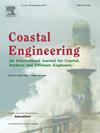A comparison of eight weakly dispersive Boussinesq-type models for non-breaking long-wave propagation in variable water depth
IF 4.2
2区 工程技术
Q1 ENGINEERING, CIVIL
引用次数: 0
Abstract
Weakly dispersive Boussinesq-type models are extensively used to model long-wave propagation in coastal areas and their interaction with coastal infrastructures. Many equations falling in this category have been formulated during the last decades, but few detailed comparisons between them can be found in the literature. In this work, we investigate theoretically and with computational experiments eight variants of the most popular models used by the coastal engineering community. Both weakly nonlinear and fully nonlinear models are considered, hoping to understand better when the additional complexity of the latter class of models is necessary or justified. We provide an overview and discuss the properties of these models, including the linear dispersion relation in uniform water depth, the second-order nonlinear coupling coefficient, the shoaling gradient, and the sensitivity to wave trough instabilities. The models are then numerically discretised using the same general strategy in a single numerical code, using fourth-order methods for time and space discretisation. Their capacity to simulate coastal wave propagation and their transformation when approaching the shore is assessed on three challenging one-dimensional benchmarks. It appears that fully nonlinear models are more consistent than their weakly nonlinear counterparts, which can occasionally perform better but show different behaviours depending on the case.
变水深非断裂长波传播的八种弱色散布森斯克模型比较
弱色散布森斯克模型被广泛用于模拟长波在沿岸地区的传播及其与沿岸基础设施 的相互作用。在过去的几十年中,已经提出了许多属于这一类的方程,但在文献中很少能找到它们之间的详细比较。在这项工作中,我们从理论上并通过计算实验研究了沿岸工程界最常用模型的八个变体。我们考虑了弱非线性和全非线性模型,希望能更好地理解后一类模型的额外复杂性是 必要的或合理的。我们概述并讨论了这些模型的特性,包括均匀水深下的线性弥散关系、二阶非线性耦合 系数、滩涂梯度以及对波谷不稳定性的敏感性。然后,在单个数值代码中采用相同的一般策略对模型进行数值离散化,使用四阶方法进行时间和空间离散化。在三个具有挑战性的一维基准上,评估了它们模拟沿岸波浪传播及其接近海岸时的变 化的能力。与弱非线性模型相比,全非线性模型的一致性更强。
本文章由计算机程序翻译,如有差异,请以英文原文为准。
求助全文
约1分钟内获得全文
求助全文
来源期刊

Coastal Engineering
工程技术-工程:大洋
CiteScore
9.20
自引率
13.60%
发文量
0
审稿时长
3.5 months
期刊介绍:
Coastal Engineering is an international medium for coastal engineers and scientists. Combining practical applications with modern technological and scientific approaches, such as mathematical and numerical modelling, laboratory and field observations and experiments, it publishes fundamental studies as well as case studies on the following aspects of coastal, harbour and offshore engineering: waves, currents and sediment transport; coastal, estuarine and offshore morphology; technical and functional design of coastal and harbour structures; morphological and environmental impact of coastal, harbour and offshore structures.
 求助内容:
求助内容: 应助结果提醒方式:
应助结果提醒方式:


